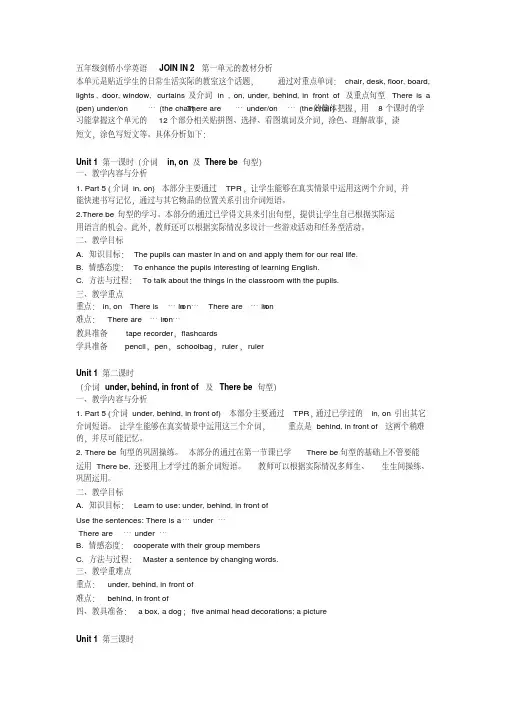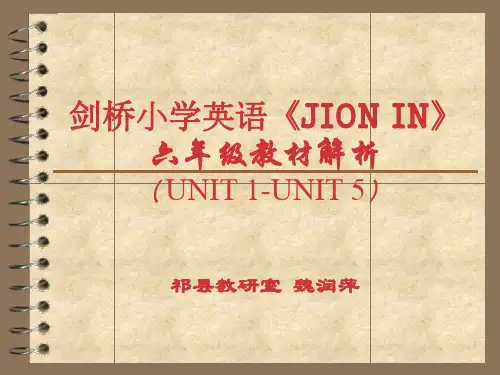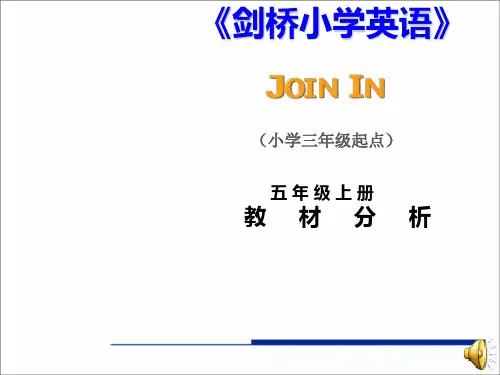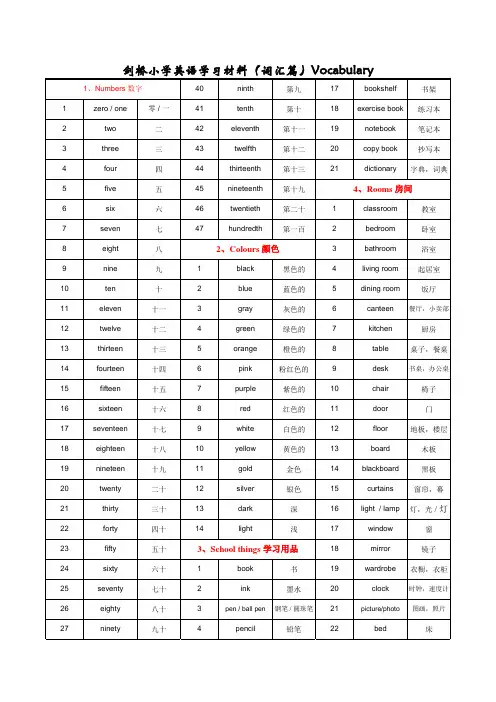剑桥小学英语
- 格式:doc
- 大小:30.00 KB
- 文档页数:5

N h=T O u(f鬳筄五年级剑桥小学英语JOIN IN 2第一单元的教材分析本单元是贴近学生的日常生活实际的教室这个话题,通过对重点单词:chair, desk, floor, board,lights, door, window, curtains及介词in , on, under, behind, in front of 及重点句型There is a (pen) under/on … (the chair)There are … under/on… (the chair)的整体把握,用8个课时的学习能掌握这个单元的12个部分相关贴拼图、选择、看图填词及介词,涂色、理解故事,读短文,涂色写短文等。
具体分析如下:Unit 1第一课时(介词in, on 及There be 句型)一、教学内容与分析1. Part 5 (介词in, on) 本部分主要通过TPR,让学生能够在真实情景中运用这两个介词,并能快速书写记忆,通过与其它物品的位置关系引出介词短语。
2.There be句型的学习。
本部分的通过已学得文具来引出句型,提供让学生自己根据实际运用语言的机会。
此外,教师还可以根据实际情况多设计一些游戏活动和任务型活动。
二、教学目标A. 知识目标:The pupils can master in and on and apply them for our real life.B. 情感态度:To enhance the pupils interesting of learning English.C. 方法与过程:To talk about the things in the classroom with the pupils.三、教学重点重点:in, on There is … in\on…There are … in\on难点:There are … in on…教具准备tape recorder,flashcards学具准备 pencil,pen,schoolbag,ruler,rulerUnit 1第二课时(介词under, behind, in front of 及There be 句型)一、教学内容与分析1. Part 5 (介词under, behind, in front of) 本部分主要通过TPR,通过已学过的in, on引出其它介词短语。



join in剑桥小学英语英语作为世界上最常用的语言,人们越来越重视其学习。
剑桥小学英语(CEP)在全球范围内享有盛誉,它是经剑桥大学考试委员会(UCLES)编写的小学英语教学课程,内容有教授学生如何读、写、听和说英语.剑桥小学英语教学课程以英国为主,采用经典教学方法,着重强调英语语言技巧的学习,激发学生的兴趣,开发学生的全部潜力,帮助学生更好的运用英语。
剑桥小学英语课程体系从P1级别(5岁以上)开始一直涵盖到P6级别4年级学生。
课程主要包括以下几大部分:阅读、写作、说话、听力和语法和词汇等,每一部分都结合了测试,能够有效帮助学生提升英语水平。
在每一级,剑桥小学英语都让学生学习关键词汇、短语和句子,帮助学生掌握英语和理解文章的能力。
每个级别中都包括各种活跃的活动,包括语言游戏、讨论和口语演练等,帮助学生轻松学习英语。
剑桥小学英语的好处不仅仅在于帮助学生学习语言技能,还可以激发学生的创造力,帮助学生成为更好的思考者。
它也能有效地提升学生的社交能力,帮助学生与同学之间更融洽的相处。
加入剑桥小学英语,你将得到更好的英语学习教育,更加有效和全面地提高学生的英语水平。
这里有许多小学英语专家可以指导学生,帮助他们掌握英文的基本知识,并学习到视、听、讲和读的技能。
剑桥小学英语的全部内容都是经过充分测试的,并通过CEP的标准内容实施,确保课程内容丰富和有趣。
孩子们可以尽情享受学习英语的乐趣,发展英语的听、说、读、写技能,从而锻炼他们的思维能力。
参加剑桥小学英语,学生将获得最优质的英语学习体验,学习到最新的英语知识,提升英语水平,在未来发展中占据优势。
参加英语课程,不仅能学到英语,还能够培养感恩之心,提升社交能力,发展人际关系等等,是学习英语最好的选择。
总之,参加剑桥小学英语可以有效提高学生的英语水平,让他们更加了解文化,拓展他们的知识面,从而在未来的发展中取得成功。

剑桥四年级英语下(习题10)听力部分一、听录音,把正确的答案序号天灾括号里。
( )1.A.15 B.50 ( )2.A.40 B.40( )3.A.song B.clock ( )4.fly B.ski( )5.A.fox B.wolf ( )6.sing B.swim( )7.curtains B.chicken ( )8.A.floor B.door( )9.Ahalf past twelf B.half past three二.听录音,勾出乡音的图片。
4.1.3.Jane Mary2. 5.StephanieJames Tim三,听录音,填空。
My name is John.I am years old.I am in Grade 4 this year.My favourite animal is a .I have got a new .There is a big in My room.I like My nice .It’s on mybed.Jeff is my friend.He can .Look at the picture,Jeff and I are .笔试部分一.按要求写单词。
Name four animals:snakeName four things in your room :chairName four things you can do:ride a bike二、看图回答问题。
1.How manywomen can you see?2.How many children arethere in the shop?3.How much is a dress?4.What’s the time?5.What day is it?判断对错。
“Yes”或“No”1.Miss Zhu is wearing a skirt? ( )2.Peter wears a cap.( )3.Li Ping is a boy. ( )4.Miss Chen has got a bag. ( )5.Miss Zhang goes to the shop with her baby. ( )toy?5.What does Linda want?二、翻译1. curtains __________2. door __________3. window __________4. under __________5. on __________6. 地板----------------7. 灯----------------8.圆形---------------9.三角形-----------------10.桌子----------------- 11.长方形 12.正方形四.看图补全句子1. There is a schoolbag ________________ a desk .2. There are two chairs _________________ the room .3. The cat is______________ the window .4. There is a chair _______________ the door .5. There are two pencils _______________the pencil-case .五.看图回答问题。



第一课时A game第二课时Listening and miming the poem第三课时Playing with partners第四课时Three games第五课时A helicopter第六课时Children in Great BritainUnit 9(3) 第一课时教学内容Playing a game教学目的1.语言技能:复习由How, What以及When引导的问句及其回答,复习句式Can you …?及其回答。
能根据要求做出相应的反应。
2.语言知识:四会掌握单词game,学习并运用做游戏时常用的相关信息。
3.情感态度:激发学生学英语的兴趣,并训练学生的识记能力以及交际能力。
教学重难点1.四会掌握单词game.2.学习并运用句子: Miss a turn. Throw again. Go back to ... Start. Finish.3.学会在实际生活中根据所提供的信息来做出相应反应。
教具准备骰子,游戏棋,转盘。
(学生带骰子)教学步骤Step 1 Warm up1.Have dialogs:教师用“what, how, when”各提一问以及“Can you…?”,请学生回答后,让同组学生互相仿例进行对话。
2.Review words:教师说“Name two kinds of colours.”启发学生说出两种颜色名称,接着又说“Name five pets.”学生很快说出五种pets来,以同样的方式复习动物、服饰、房间、星期、月份等类别的单词.Step 2 Presentation1.学习单词,出示一游戏棋问:“What’s this?”学生回答“A game.”教师接着说“Let’s spell the word game, then play a game, ok?”学生拼读并用手书空。
2.轮流转转盘学新句型。
将写有“开始”“终止”“返回”“停留一回合”“再投一次”(一面写中文,一面写英文)等游戏规则的转盘请两学生转动,当其停下来时,请学生试着说出其英文一面的句子来。

《剑桥小学英语Join in —入门阶段》教材教法分析(上)一、教材分析:(一).教材特点:《Join in 》教材的突出特点表现在以下几个方面:1.以学生为主体,全面提高学生的素质。
2.教学方法先进,反映国际教学的趋势。
3.目标设置科学,符合国家小学英语课程目标要求。
4.教材内容广泛,体现现代社会的气息。
5.教学资源丰富,有利于小学课程的拓展。
本套教材非常显著的特点之一是借鉴了多元智能理论,儿童的能力和智力各不相同,每个人的学习方式也不一样,教材中用语言、数学逻辑思维、音乐、空间、身体运动等不同的语言载体来开发学生的多元智能学习语言,在语言学习的过程中关注孩子们方方面面的成长,评价系统、全面,是一套很有思想,有创意的教材,老师能否把这些多种智能考虑在内,尤其是在评估学生时能否充分发掘这些智能就显得非常重要。
其次,本教材借鉴的另一重要理论是全身反应法(TPR)。
根据这个理论,人们只有在视觉、听觉和身体方面全面参与,学习才能稳定持久。
那种认为学生只要顺利完成书本中的练习便能学会语言结构和单词的看法是错误的,或者只对少数通过语言智能和逻辑数学智能形式学习的学生有效。
另外,这套教材的编写适合西方的国情,而给中国小学英语教师的教学带来一定的难度,如,对教材体系难以把握,教材中的文化背景涉及到的国家多,对教师自身的英语文化知识是很大的挑战,任务型教学适合小班教学,不少教学活动在我们现在七、八十人的大班里很难开展。
所以我们在解读教材时,有时有必要根据自己的学情和班情,将教材上语言活动进行相应的调整。
(二)、大纲要求激发和培养学生学习英语的兴趣,使学生树立信心,养成良好的学习习惯和形成有效的学习策略,发展自主学习的能力和合作精神;使学生掌握一定的英语基础知识和听、说、读、写技能,形成一定的综合语言运用能力;培养学生的观察、记忆、思维、想象能力和创新能力(精神);帮助学生了解世界和中西方文化的差异,形成健康的人生观,为他们的终生学习和发展打下良好基础。

教学内容:《Join In》剑桥小学英语学生用书2(五年级)Unit 10 of Book 2 Holidays:A story --- The monster.执教者:武汉市光谷第一小学汪远琦一.教材说明《剑桥少儿英语》是英国剑桥大学出版社2000年最新出版的教材。
它以非英语国家的少年儿童为学习对象,学习内容与小学生的生活紧密相连,吸收了大量新的教学思想和方法,充分运用国际上先进的外语教学研究成果,注重学生运用语言能力的培养,使教材和教学过程成为对少年儿童各种外显的语言活动与智能开发和英语综合运用能力的优化整合。
同时,教学内容也可根据实际情况自由随意组合,适时调整。
本教材的突出特点体现在以下几个方面:1.学生为主体,全面提高学生的素质;2.教学方法先进,反映国际教学的趋势;3.目标设置科学,符合国家小学英语课程目标的要求;4.教材内容广泛,体现现代社会的气息;5.教学资源丰富,促进小学课程的拓展。
二.教学指导思想在《英语课程标准》的引领下,我将本课的指导思想确定为:让学生主体参与,主动探究,合作互动,协调发展。
基本教法为:创设情境,营造和谐氛围;强化听说,突出学生主体地位;培养语感,发展学生潜能。
面向全体,引导学生参与学习过程,适当利用教辅手段,充分体现英语的学科特点,注重听说能力的培养,尽量全英语组织教学,逐步培养学生良好的听力以及运用语言的能力。
基本学法:学生个体活动,小组合作,全班齐动交替进行,让学生在“动”、“玩”、“乐”的中爱学,轻松获取知识,变以往学生被动接受知识的过程为主动探究、创造的过程。
三.教学设计.Ⅰ.Teaching Aims.(教学目标)1.Knowledge Aims.(知识目标).(1)能理解故事内容,并学习和使用现在进行时这种新的时态;(2)能给故事设计一个合理地结尾;(3)能运用简单的对话进行交流,并能听、说、演故事。
2.Ability Aims.(能力目标).通过实践性学习培养学生的听、说、读、写,以及综合运用英语进行交际的能力。

(Join In)剑桥小学英语入门阶段教材分析安徽街小学 李娅敏1. 教材分析(一)教学目标《英语课程标准》明确指出:基础教育阶段英语课程的总体目标是培养学生的综合语言运用能力。
强调课程从学生的学习兴趣、生活经验和认知水平出发,倡导体验、实践、参与、合作与交流的学习方式和任务型的教学途径。
三年级是英语教学的起始阶段,尤其要激发和培养学生的学习兴趣,树立自信心,养成良好的学习习惯和形成有效的学习策略,发展合作精神,使学生掌握一定的英语基础知识和听、说、读、写技能。
本学期主要以培养兴趣,抓好双基,培养学生的英语语言运用能力为总目标和指导思想。
(二)编写思路以话题为纲. 以功能为主线融汇语言基础有效完成任务话题——功能——结构——任务以话题为纲,以交际功能和语言结构为主线,逐步引导学生运用英语完成有实际意义的语言任务。
也就是我们通常说的“用英语做事情”。
(三)教材特点1.课堂活动丰富多彩,能够激起小学生的浓厚兴趣。
2.教学内容生动活泼,易于老师和学生教学和学习。
3.教学方法紧跟潮流,能使学生在情景中运用英语。
4.根据多元智能原则。
培养学生综合运用英语能力。
5.卡通人物幽默可爱,引导学生自然学习故事歌曲。
(四)教材内容三年级全册总共9个单元和3个复习单元。
涉及到的话题有问候、自我介绍、数字、玩具、颜色、文具、教室、早餐、糖果和圣诞节等。
同时还包含了26个字母,在前三个单元教学完毕。
具体内容如下:1.能听懂、会说19组会话,并能进行简单的交流。
2.能听、说、认读57个单词和听、说、读、写26个字母和数字类、颜色类、文具类、教室类等主题的单词,并能简单地运用。
3.能认识中外人名15个。
4.能听懂教师的课堂用语。
5.能唱6首歌曲。
6.能唱6首chant。
7.能完成3个自我评价活动。
8.能听懂4个小故事。
9.能完成1个手工小制作。
(五)教材重点与难点1.教材重点: 能听、说、读、写英语字母Aa--Zz 培养良好的书写习惯,能做到书写规范、整洁 能比较熟练地运用所学的日常交际用语2.教材难点: 能比较熟练地运用所学的日常交际用语。
Lesson1 (1&2)Aims and goals:11..M M a a k k e e s s u u r r e e t t h h e e p p u u p p i i l l s s c c a a n n u u s s e e t t h h e e n n u u m m b b e e r r s s::11--1122..22..S S i i n n g g t t h h e e s s o o n n g g::T T h h e e n n u u m m b b e e r r s s r r o o c c k k..““D D o o t t h h e e n n u u m m b b e e r r s s r r o o c c k k..””33..T T h h e e p p u u p p i i l l s s c c a a n n s s a a y y t t h h e e c c h h a a n n t t::T T h h e e t t i i g g e e r r j j u u m m p p..““L L e e t t’’s s d d o o t t h h e e t t i i g g e e r rj j u u m m p p..Y Y i i p p p p e e e e!!””Key points:The pronunciations of eleven and twelve.Teaching Aids:CAI; A tape recorder; The mask of Toby. Word cards and pictures of numbers: 1-12; foam clock, number cards(words)Teaching Process:Step 1: Warming up / Review.1.Greetings:Good morning / afternoon, boys and girls. How are youtoday?2.Sing a song: The number song.Step 2: Presentation (1)1. A game: number line-up (0-10) – hand out numbers to 13 Ss thenhave Ss line-up in correct order, class counts and Ss step out when their number is called. See which group is the fastest.2. Drills①T T e e a a c c h h1111a a n n d d1122,,s s p p e e l l l l t t h h e e w w o o r r d d s s,,t t e e a a c c h h o o’’c c l l o o c c k k b b y y u u s s i i n n g g t t h h e e①f f o o a a m m c c l l o o c c k k((a a s s k k‘‘W W h h a a t t t t i i m m e e i i s s i i t t??’’t t o o s s e e e e i i f f a a n n y y S S s s k k n n o o w w t t h h i i s s??))②S S i i n n g g t t h h e e s s o o n n g g::T T h h e e n n u u m m b b e e r r s s r r o o c c k k..②i i..L L i i s s t t e e n n t t o o t t h h e e s s o o n n g g a a n n d d w w a a t t c c h h T T,,s s e e c c o o n n d d t t i i m m e e f f o o l l l l o o w w t t h h e e T T..i i i i..L L i i s s t t e e n n a a g g a a i i n n a a n n d d p p o o i i n n t t t t o o t t h h e e w w o o r r d d s s o o n n t t h h e e b b o o o o k k w w h h i i l l e e s s a a y y i i n n g gt t h h e e w w o o r r d d s s..((T T w w i i c c e e))i i i i i i..L L i i s s t t e e n n a a g g a a i i n n a a n n d d t t r r y y t t o o s s i i n n g g t t h h e e s s o o n n g g..((S S e e v v e e r r a a l l t t i i m m e e s s))Step 3: Presentation (2)11..L L e e a a d d i i n n::T T o o b b y y w w a a n n t t s s t t o o j j o o i i n n t t h h e e r r o o c c k k a a n n d d h h e e t t a a k k e e a a l l o o n n g g a a s s o o n n g g a a l l s s o o..H H e e w w a a n n t t s s t t o o s s h h a a r r e e t t h h e e s s o o n n g g w w i i t t h h e e v v e e r r y y b b o o d d y y..22..((C C A A I I))P P l l a a y y t t h h e e s s o o n n g g a a n n d d a a s s k k S S s s t t o o s s a a y y w w h h a a t t t t h h e e y y h h a a v v e e h h e e a a r r d d::T T h h e et t i i g g e e r r j j u u m m p p..C C o o m m e e o o n n,,l l e e t t’’s s d d o o t t h h e e t t i i g g e e r r j j u u m m p p..Step 4: practiceGame: T says “The tiger”and Ss say “jump”while jumping then exchange1.Watch and listen to the CAI. Watch it again and T and Ss do theactions together.2.Watch again and sing the song.3. Sing the song by different roles and a pupil sing in the front. (boys vs. girls)Step 5: ConsolidationStep 6: Homework1. Listen to the tape on P8 three times and sing the song to the parents.2. Bring the colouring pens and 2 dice tomorrow.Lesson 2(3 , 4 &5)Aims and goals:11..M M a a t t c c h h t t h h e e w w o o r r d d w w i i t t h h t t h h e e n n u u m m b b e e r r..22..L L i i s s t t e e n n t t o o t t h h e e c c o o n n v v e e r r s s a a t t i i o o n n s s a a n n d d m m a a t t c c h h t t h h e e n n a a m m e e s s o o f f c c h h i i l l d d r r e e n n w w i i t t h hn n u u m m b b e e r r s s o o n n d d i i c c e e..33..P P l l a a y y t t w w o o n n u u m m b b e e r r s s g g a a m m e e s s..44..C C a a n n s s a a y y t t h h e e s s e e n n t t e e n n c c e e::Y Y o o u u r r t t u u r r n n,,((S S a a m m))..Key Points:D D i i s s t t i i n n g g u u i i s s h h t t w w o o a a n n d d t t e e n n,,f f o o u u r r a a n n d d f f i i v v e e,,s s i i x x a a n n d d t t h h r r e e e e..Teaching Aids:A tape recorder; Word cards and pictures of numbers: 1-12; 2 big dice. Teaching Process:Step 1: Warming up / Review.1.Greetings:Good morning / afternoon, boys and girls. How are youtoday?2.Sing a song and say the chant: The numbers rock & The tigerjump.Step 2: Presentation (1)1. A game: Flash the word cards of numbers and Ss speak it outloudly.2. Read the words on the Bb. (t t w w o o a a n n d d t t e e n n,,f f o o u u r r a a n n d d f f i i v v e e,,s s i i x x a a n n d dt t h h r r e e e e..e e l l e e v v e e n n a a n n d d t t w w e e l l v v e e)33..S S t t i i c c k k t t h h e e w w o o r r d d c c a a r r d d s s t t o o t t h h e e n n u u m m b b e e r r s s o o n n B B b b..Step 3: practice1.Listen to the tape and match the names with the numbers.2.Check the answers.3.Play a game: 2 dice gameYour turn, (Sam).Step 5: ConsolidationStep 6: Homework1.Listen to the tape on P9 three times and read the numbers inEnglish 3 times.2.Colour the numbers on P9 if no time in classLesson3(7, 8)Aims and goals:1. In this lesson the children learn to say:(Twelve) is (two) plus (ten),Now let’s start again.2. Pupils can say the sentence pattern: How many?3. Say the rhyme.Key Points:Learn to say the rhyme.Teaching Aids:A tape recorder;Teaching Process:Step 1: Warming up / Review.1.Greetings:Good morning / afternoon. What did you eat forbreakfast?2.Sing the song: The numbers rock. & The tiger jump.3.Ask Ss to spell the words of numbers: zero, one, two, three,Step 2: Presentation (1)1.Lead in : A guessing gameT hides the fingers behind the back and ask the Ss to guess howmany?2. Drill: Ask Ss to come to the front to hide their fingers, playing thisgame. And then practise in pairs.3. The game is going on, T hides the fingers again (12) and Ss guesshow many. After guessing it out, T shows the fingers and says ‘ Twelve is two plus ten.’44..T T a a k k e e a a n n o o t t h h e e r r e e x x a a m m p p l l e e s s..A A s s k k S S s s t t o o t t r r y y t t o o m m a a k k e e s s e e n n t t e e n n c c e e s s a a b b o o u u t tt t h h i i s s s s e e n n t t e e n n c c e e p p a a t t t t e e r r n n..Step 3: practice1.Listen to the rhyme again and again and try to say it.2.A game: Ten Ss stand in a circle and say this rhyme word by wordto see who is the final winner. (If wrong, he or she should be quit.) Step 5: ConsolidationStep 6: Homework1.Listen to the tape and say the rhyme 3 times.2.Practise the target sentence pattern.3.Recite ‘four’ and ‘ five’.Blackboard design / Note:Lesson4(9,10,11)Aims and demands:1. In this lesson the children learn to say : What’s your phone number? My phone number is …2. Listen and write the correct numbers.Teaching Important and Difficult Points:What’s your phone number? My phone number is …Teaching Aids:A tape recorder; Word cards of numbers;Teaching Process:Step 1: Warming up / Review.1.Greetings:Good morning / afternoon, boys and girls. How are youtoday? (出示句型卡片)2.Sing the song: The numbers rock. & The tiger jump.3.Ask Ss to spell the words of numbers: zero, one, two, three, four,fiveStep 2: Presentation (1)1.Lead in : Show a phone and tell the number of T to the SS. ‘Myphone number is .’‘ What’s your phone number? ( 板书,带读)2.Write down their own numbers of Part 10.3.Drill: Practise in 4 Ss and fill in the blanks on P13, Part 11. (Name,phone number)4. Ask Ss to the front to answer other s’ question with ‘ What’s yourphone number?’ ‘My phone number is…’Step 3: practice1.Listen to the tape and write the phone numbers of Part 9. (先认人名:Alice, Paul, Lisa)2.Listen again and check the answers. (个别学生演板)Step 5: ConsolidationStep 6: Homework1.Listen to the tape and read it 3 times.2.Recite ‘six’ and ‘ seven’.Lesson5(12)Aims and demands:1. In this lesson the children learn to say:How many …can you see? Let me count. I can see…Teaching Important and Difficult Points:…??’’D D i i f f f f e e r r e e n n t t p p r r o o n n u u n n c c i i a a t t i i o o n n s s a a b b o o u u t t‘‘s s’’a a f f t t e e r r‘‘H H o o w w m m a a n n y y…Teaching Aids:A tape recorder; Word cards of sentence; PPTeaching Process:Step 1: Warming up / Review.1.Greetings:Good morning / afternoon, boys and girls. How are youtoday?2.Sing the song: The numbers rock. & The tiger jump.3.Ask Ss to spell the words of numbers: zero, one, two, three, four,five…4.Review the dialogue between the T and S or S and S.‘What’s your phone number?’‘My phone number is…’Step 2: Presentation (1)1.L L e e a a d d i i n n::P P o o i i n n t t t t o o s s o o m m e e S S s s a a n n d d a a s s k k‘‘H H o o w w m m a a n n y y??’’a a n n d d‘‘H H o o w w m m a a n n y yb b o o y y s sc c a a n n y y o o u u s s e e e e??’’( 板书,带读)22..Replace the words in this sentence. (girls, flags…)33..Teach the answer: Let me count. One, two, three …I cansee…( 板书,带读)Step 3: practice1.Show PP and No.1&2 are said by all the SS. The rest are said bySs. (One asks, the other answers.)2.Practise in pairs: They can ask anything they can say.Step 5: Consolidation1. Ask S to the front to ask the target sentences. Others answer.Step 6: Homework1.Read the content on P 14 three times.2.Ask and answer in pairs.Blackboard design / Note:Lesson6(13,14)Aims and demands:1. In this lesson the children learn to say:What is …plus /and…?What is …minus…?plete the word puzzle.Teaching Important and Difficult Points:R R e e m m e e m m b b e e r r t t h h e e w w r r i i t t t t e e n n w w o o r r d d s s o o f f n n u u m m b b e e r r s s::00--1122((e e i i g g h h t t,,t t w w e e l l v v e e)) Teaching Aids:A tape recorder; The word cards of numbers.Teaching Process:Step 1: Warming up / Review.1.Greetings:Good morning / afternoon, boys and girls. How are youtoday?2.Say the rhyme on P12.3.Show some pictures or real things to ask ‘How many …s can yousee?’4.Spell the words of numbers.Step 2: Presentation1.Lead in: Show the number cards and ask ‘How many numbers canyou see?’.(用数字图片)So ‘What is …plus /and…?’‘What is …minus…?’( 板书,带读)2.Drill: Replace the words.33..Practise between T and Ss. Ss give the questions to the T.Step 3: practice1.Pratise in pairs on P 15, part 13.2.A game: Looking for the neighbours.z e r o o n e t w o thr ee f ou r f i v e s i xs e v e n ei gh t n i n e t e n e l e v e n tw e lv e3. Complete the word puzzle on Part 14.Step 5: ConsolidationStep 6: Homework1.Read the contents on P15 3 times.2.Write the 13 number words without looking at the books threetimes.Lesson7(6)Aims and demands:In this lesson the children learn to understand:What’s in the box?Guess the number.Snails.Here’s your prize, Emma.Thank you.Great!Teaching Important and Difficult Points:T T r r y y t t o o s s a a y y t t h h e e t t a a r r g g e e t t s s e e n n t t e e n n c c e e s s a a n n d d a a c c t t t t h h e e s s t t o o r r y y o o u u t t..Teaching Aids:A tape recorder; The word cards of numbers; Tow boxes, one with snails in it and one with pencils or pens in it.Teaching Process:Step 1: Warming up / Review.1.Greetings:Good morning / afternoon, boys and girls. How are you today?2.Sing the songs: The numbers song and tiger jump.3.Spell the words of numbers.Step 2: Presentation1.Lead in:A Game: Show a box and ask ‘What’s in the box?’and ask Ss to guess.‘Guess the number. How many?’( 板书,带读。
Starter Unit-Unit1重点识记内容一.四会单词(要求会听说读写)apple苹果bed床cat猫dog狗egg鸡蛋go走this这,这个new新的I我you你my我的your你的二.三会单词(要求会听说读,知道单词意思)skateboard滑板child孩子(复数形式为children)and和is是(单数)are是(复数)am是(用于I后)hello你好look看listen听mime模仿write写sing唱speak说draw画think想,思考guess猜read阅读colour涂色play玩morning早上name名字tiger老虎Miss小姐today今天OK行,可以fine健康的Mr先生hop跳stop停止begin开始三.三会短语和句子(要求会听说读,知道短语和句子意思)Say“hello”.说“你好”。
Sit down坐下。
Stand up.起立。
Clap your hands.拍手Stretch.伸展Stand back to back.背靠背站着。
Stand nose to nose.鼻子贴鼻子站着。
Stand arm in arm.手挽手站着。
1.Good morning!早上好!2.Hello!你好!3.-Goodbye!再见!-Bye!Bye-bye!再见!4.-What’s your name?你叫什么名字?-I’m Toby/Bob/Lisa/Nick/Rita.我叫托比/鲍勃/丽莎/尼克/瑞塔。
5.-How are you today?你今天好吗?-I’m OK.我还好。
-I’m fine.我很好。
(两种回答任选一种)6.-What’s this?这是什么?-My new skateboard/apple/bed/cat/dog/egg.我的新滑板/苹果/床/猫/狗/鸡蛋。
7.Are you ready?你准备好了吗?一.重点单词(加粗的是四会单词,不加粗的是三会单词)numbers数字(复数)zero0one1two2three3 four4five5six6seven7eight8 nine9ten10flag旗帜guitar吉他horse马ice cream冰淇淋juice果汁kite风筝二.三会单词(要求会听说读,知道单词意思)box盒子crayon蜡笔snail蜗牛do做,干great非常好的,大的super极好的yes是,对no不thank感谢三.三会句子(要求会听说读,知道句子意思)1.-What’s your phone number?你的电话号码是什么?-My phone number is8308764.我的电话是8308764。
六年级剑桥小学英语下册第二单元知识归纳单班级: _______姓名:_______一、听说读写四会单词(短语)active好动的fit健壮的,健康的glass一杯之量habit习惯health健康healthy健康的,健壮的kind种类look after照顾,照料not…at all一点也不own自己的plenty(of)丰富,充足stay维持warm热情的,热忱的饮食类词汇:apple苹果pear梨carrot sticks 胡萝卜条celery芹菜grapes 葡萄cherry / cherries 樱桃string beans菜豆corn-on-the-cob 玉米棒cola可乐candy / candies 糖果milk牛奶fruit水果vegetable蔬菜hamburger汉堡chips薯片chocolate巧克力bread面包chicken鸡egg蛋juice果汁brown rice 糙米whole grains天然谷物grain foods 谷物食品food食品drinks饮品fast food 快餐protein蛋白质meat肉oil 油salt食盐sugar食糖sweets糖果,甜食fat脂肪谚语:1.You are what you eat. 人如其食。
(健康的饮食,才有健康的身体。
)2.An apple a day keeps the doctor away. 一天一个苹果,医生远离我。
二、听说读写四会句子P14-11.If you have a favourite food, you can try a new one.如果你有喜欢的食物,尝试一下新的食物。
2.You can try new foods, something new to you. 你可以尝试新食物,对你而言的新东西。
P15-33.Red fruit and vegetables are good for your heart. 红色的水果和蔬菜对心脏有益。
六年级(上学期)教材分析Starter Unit Welcome back一、单元教学目标:1、确保学生以一种乐观积极的态度,轻松自然的过度到新学期英语知识的学习。
2、复习三、四、五年级所学的一些关键词和词组。
3、复习和巩固所学的语言知识。
4、活动和技能:唱歌;复习单词、词组、句型;按顺序列出单词;语音练习;分辨同音词。
二、单元教学重点:上述目标的达成。
三、单元教学难点:活动的有效开展和技能的形成。
四、单元课时安排:三课时。
五、课时划分及教学安排:第一课时一、教学内容:Part 1 Listen and sing the song二、教学目标:1、复习巩固:Crazy, rock.2、学习掌握:Ride a cow, through the street, blow a kiss to a policeman, ride away,bake a cake, shake your legs, break an egg.3、活动技能:唱歌。
三、教学重点:上述目标的复习巩固和学习掌握部分。
四、教学难点:上述目标的学习掌握和活动技能部分。
第二课时一、教学内容:Part 2 Categories. Write the words.二、教学目标:1、复习巩固掌握:Words of animals, clours, toys and school uniform. Days of the week. Words of feelings and food. Things in a living room. Numbers, free time activities.2、活动技能:复习单词、词组、句型;按顺序列出单词。
三、教学重点及难点:上述目标的复习巩固掌握和活动技能部分。
第三课时一、教学内容:Part 3 Write the words below the pictures. Find the rhyming pairs. Draw the missing shapes.二、教学目标:1、复习巩固掌握:Words of the same rhyming.2、活动技能:语音练习;分辨同音词。
《剑桥小学英语》(入门阶段——学生用书4) 四会词汇及句型表Numbers (数字)one, two, three, four, five, six, seven, eight, nine, ten, eleven, twelve, thirteen, fourteen, fifteen, sixteen, seventeen, eighteen, nineteen, twenty,thirty, forty, fifty, sixty, seventy, eighty, ninety, ninety-one ……ninety-nine, a hundredWhat’s the number? It’s (six).What is (seven) and (three)? (Ten).What’s (five) minus (five)? (Zero)What’s your phone number? My phone number is……Toys(玩具)ball, doll, skateboard, frog, crocodileConveyance (交通工具)car, plane, train, boat, bike, bus,subway,helicopterColours (颜色)red, green, yellow, blue, brown, pink, orange, black, white, purple, grayWhat colour is it? It’s (blue).What colour do you like?I like (pink) and (yellow). I like (orange) too.What’s your favourite colour? Is it (blue)?Yes, that’s right.School things (学习用品)pen, pencil, book, pencil case, schoolbag, ruler, eraser, skipping ropeWhat’s this in English? It’s a (book).How many (red) things are there? There are (three red) things.How many (pens) have you got? I have got (two pens).My classroom (我的教室)door, window, board, floor, desk., chair, curtains, lightin/on/under/behind/in front of the (box)What colour is the (board)? It’s (black).What colour are the (chairs)? They’re (yellow).There is a brown floor.There are three green and yellow bags.Food(食物)milk, toast, jam, tea, juice, rolls, ham, cornflakes, sausage, rice, apples, bananas, eggs, cakes, ice cream, chocolates, lollipop, popcorn, butter, oranges, fish, honey, hot dog, hamburger, sandwich, pizza, chicken, spaghetti, cheese, hot chocolate, orange juice, cola, noodles, steamed bread, porridge, dumplings, pork, beef, plums, chewing gum,apricot,grape,peach,pineapple,pear,watermelon,lemon,mango,strawberry,cherry,peanutI love (tea). I like (juice). I don’t like (bread).Have some juice. Thanks. Here you are. Thank you.Thank you very much. That’s all right/OK.Do you like (apples)? Yes, I do. / No, I don’t.What do you like? (Ice cream).How much is it? It’s 3 yuan.How much are they? They’re 22 yuan.I’m going to buy (ice cream).What do we need? I can bring (a cake).What about (bananas)? Great idea.Christmas(圣诞节)Merry Christmas! Happy New Year to you! The same to you!Pets (宠物)cat, dog, mouse, hamster, rabbit, budgie, fish, frogone mouse---two mice one cat---two catsHave you got a pet? Yes, I have. / No, I haven’t.What have you got? (A cat).The days of the week (一周七天)Monday, Tuesday, Wednesday, Thursday, Friday, Saturday, SundayWhat’s your favourite day? (Friday).My favourite (pet) is (a cat).Subjects (学科)Maths,English,Chinese,Japanese,chemistry,physics,biology,art,music,geography,history,P.EClothes (衣服)T-shirt, jeans, cap, dress, socks, shoes, trainers, sweater, shirt, skirt, shorts, tie, blouse, trousers, cardigan, blazer, school uniforma pair of (shoes)(Mike) is wearing (a green cap, a red T-shirt, green jeans, black socks and brown shoes).Put on your (yellow T-shirt)Happy birthday! (生日快乐!)月份:January, February, March, April, May, June, July, August, September, October, November, December四季:Spring ,Summer,Autumn(Fall),WinterWhen is your birthday? In (May).Fred’s birthday is in (June).Feelings(感觉)sad, happy, angry, tired, scaredHe/She is (happy).How are you feeling today? I’m (happy).Body (身体部位)hair, ears, legs, feet, nose, toes, arms, face, mouth, teeth, hands, head, eyes, knees, stomach,toenail,tongue,shoulderbig (hands) small (feet)He’s got (a red nose). She’s got (black hair).Free time (空闲时间)play the piano, play table tennis, play football, stand on your head, swim, roller blade, ski, ride a horse, drive a racing carI/He/She can (sing). I/He/She can’t (sing).Can you (swim)? Yes, I can. / No, I can’t.Time (时间)What time is it? It’s (one) o’clock.It’s quarter past (one). It’s half past (one). It’s (ten) to (nine).How many (English words) can you (write)? I can …….How many (English words) can she/he (write)? She/He can …….Friends (朋友)music, sport, books, dogs, spiders, frogs, kites, cars, caps, cats, butterflies, ratsShe/He likes (books).Her/his name is (Linda).Who is your best friend? My best friend is (Emma).How old is she/he? She/He is (nine) years old.What’s her/his favourite (food)? Her/His favourite (food) is (pizza).When is her/his birthday? Her/His birthday is in (June).What has she/he got? She/He has got a (dog).Animals (动物)lion, pig, cow, hippo, fox, wolf, sheep, snake, duck, elephant, crocofrog, crocodile,crow,peacock,chicken,leopard,zebra,giraffe,butterfly,tortoise,panda,owl,bear,whale,shark,seal,swan,sea horse,sea lion,dragon,spider,turtle,goat,gooseDoes it live (in Africa)? Yes, it does. / No, it doesn’t.Has it got (two legs)? Yes, it has. / No, it hasn’t.Can it (sing)? Yes, it can. / No, it can’t.Is it (brown)? Yes, it is. / No, it isn’t.My room (我的房间)mrror, wardrobe, clock, lamp, sofa, table, pictureWhere’s my (pencil)? Look (under the wardrobe).It’s there. / It’s not there.Games (游戏)triangles, circles, rectangles, squaresHolidays (假日)paint a picture, ride a bike, play table tennis, sing a song, eat spaghetti, eat pizza, watch TV What’s (Nick) doing? (Nick) is (painting a picture).What are you doing? I am (riding a bike).What are they doing? They are (watching TV).Mascots(幸运物)ring, shells, silver bells, necklace, soft toys, friendship bandI have (twenty shells).Dreams(梦)I often/ sometimes/ never dream that (I can fly).I often/ sometimes/ never dream of (being a superstar).He/She often/ sometimes/ never dreams that (I can fly).He/She often/ sometimes/ never dreams of (being a superstar).What do you collect? (你收集了什么?)stickers, comics, (football) pictures, postcards, stamps, autographsI stick (them) on (my schoolbag).What do you want/collect? I want/collect (stamps).She/He collects (comics). She/He doesn’t collect (stickers).Life in the Arctic (北极生活)polar bears, Arctic foxes, Arctic hares, snowy owlsHow big are polar bears? 3 meters high, 650 kilos.When do Arctic foxes live in groups? In winter.Where can the Arctic hares hide in winter?They can hide in the tunnels.Television (电视)cartoons, nature programmes, sports programmes, romantic films, detective films, science fiction filmsShe/He likes (cartoons).She/He doesn’t like (romantic films).(Cartoons) are interesting/ great / boring.What do you watch?I always/ often/ sometimes/ never watch (cartoons).(The cartoon) begins at nine o’clock.Construction (建筑物)bus stop,church,train station,post office,police station,bank,school,park,museum,shop,shopping mall,supermarket,cinemaExcuse me. Where’s the (museum)? Turn left/right. Go straight ahead. Go past the (park). Take a taxi.日常交际用语:Hello! / Hi! Good morning/ afternoon/ evening/ night.What’s your name? I’m ……/ My name is …….How are you today?I’m fine/ very well / OK. Thank you. And you?This is ……. Nice to meet you.It’s good to see you again.Goodbye/Bye.。